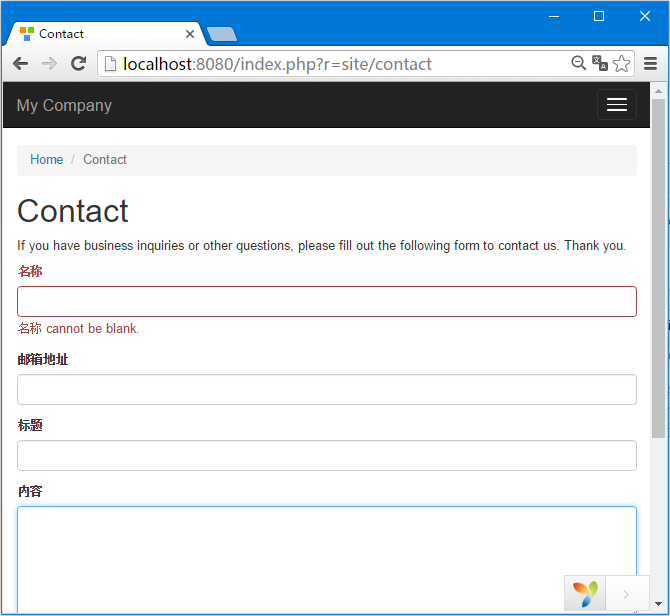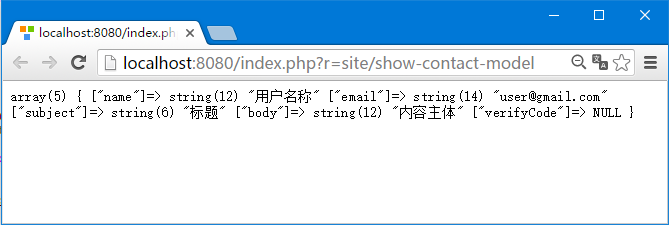属性
属性代表业务数据。它们可以像数组元素或对象的属性那样来访问。一个模型的每个属性都是公开访问的属性。要指定模型拥有什么属性,应该重写yii\base\Model::attributes() 方法。
<?php
namespace app\models;
use Yii;
use yii\base\Model;
/**
* ContactForm is the model behind the contact form.
*/
class ContactForm extends Model {
public $name;
public $email;
public $subject;
public $body;
public $verifyCode;
/**
* @return array the validation rules.
*/
public function rules() {
return [
// name, email, subject and body are required
[['name', 'email', 'subject', 'body'], 'required'],
// email has to be a valid email address
['email', 'email'],
// verifyCode needs to be entered correctly
['verifyCode', 'captcha'],
];
}
/**
* @return array customized attribute labels
*/
public function attributeLabels() {
return [
'verifyCode' => 'Verification Code',
];
}
/**
* Sends an email to the specified email address using the information
collected by this model.
* @param string $email the target email address
* @return boolean whether the model passes validation
*/
public function contact($email) {
if ($this->validate()) {
Yii::$app->mailer->compose()
->setTo($email)
->setFrom([$this->email => $this->name])
->setSubject($this->subject)
->setTextBody($this->body)
->send();
return true;
}
return false;
}
}
?>
public function actionShowContactModel() {
$mContactForm = new \app\models\ContactForm();
$mContactForm->name = "contactForm";
$mContactForm->email = "user@gmail.com";
$mContactForm->subject = "标题";
$mContactForm->body = "内容主体";
var_dump($mContactForm);
}
如模型是从 yii\base\Model 扩展,那么它的所有成员变量应该为公共且是非静态的属性。在 ContactForm 模型五个属性 - name, email, subject, body, verifyCode,也可以再添加一些新的。
属性标签
在应用中我们经常需要使用属性相关联来显示标签。默认情况下,属性标签由 yii\base\Model::generateAttributeLabel() 方法自动生成。要手动声明属性标签,可以覆盖yii\base\Model::attributeLabels() 方法。
public function attributeLabels() {
return [
'name' => '名字',
'email' => '邮箱地址',
'subject' => '标题',
'body' => '内容',
'verifyCode' => '验证码',
];
}
模型使用在不同的场景
可以使用模型在不同的场景。 例如,当一个访问用户要发送一份联系表单,我们需要所有的模型属性。 当用户已经登录,我们并不需要他的名字,因为我们可以很容易地从数据库把它读取出来。
要声明场景,应该覆盖 scenarios() 函数。它返回一个数组,其键是场景名称而其值是 Active 属性。Active属性是用来来验证的。它们也可以被大量分配。
<?php
namespace app\models;
use Yii;
use yii\base\Model;
/**
* ContactForm is the model behind the contact form.
*/
class ContactForm extends Model {
public $name;
public $email;
public $subject;
public $body;
public $verifyCode;
const SCENARIO_EMAIL_FROM_GUEST = 'EMAIL_FROM_GUEST';
const SCENARIO_EMAIL_FROM_USER = 'EMAIL_FROM_USER';
public function scenarios() {
return [
self::SCENARIO_EMAIL_FROM_GUEST => ['name', 'email', 'subject',
'body', 'verifyCode'],
self::SCENARIO_EMAIL_FROM_USER => ['email' ,'subject', 'body',
'verifyCode'],
];
}
/**
* @return array the validation rules.
*/
public function rules() {
return [
// name, email, subject and body are required
[['name', 'email', 'subject', 'body'], 'required'],
// email has to be a valid email address
['email', 'email'],
// verifyCode needs to be entered correctly
['verifyCode', 'captcha'],
];
}
/**
* @return array customized attribute labels
*/
public function attributeLabels() {
return [
'name' => '名字',
'email' => '电子邮箱',
'subject' => '标题',
'body' => '内容',
'verifyCode' => '验证码',
];
}
/**
* Sends an email to the specified email address using the information
collected by this model.
* @param string $email the target email address
* @return boolean whether the model passes validation
*/
public function contact($email) {
if ($this -> validate()) {
Yii::$app->mailer->compose()
->setTo($email)
->setFrom([$this->email => $this->name])
->setSubject($this->subject)
->setTextBody($this->body)
->send();
return true;
}
return false;
}
}
?>
我们增加了两个场景。一个用于访问游客用户,另一个用于身份验证的用户。当用户通过验证后,再不需要他填入名字。
public function actionContact() {
$model = new ContactForm();
$model->scenario = ContactForm::SCENARIO_EMAIL_FROM_GUEST;
if ($model->load(Yii::$app->request->post()) && $model->
contact(Yii::$app->params ['adminEmail'])) {
Yii::$app->session->setFlash('contactFormSubmitted');
return $this->refresh();
}
return $this->render('contact', [
'model' => $model,
]);
}
第3步 - 在浏览器访问URL => http://localhost:8080/index.php?r=site/contact 。你应该已经注意到,当前所有模型的属性都是必须的。
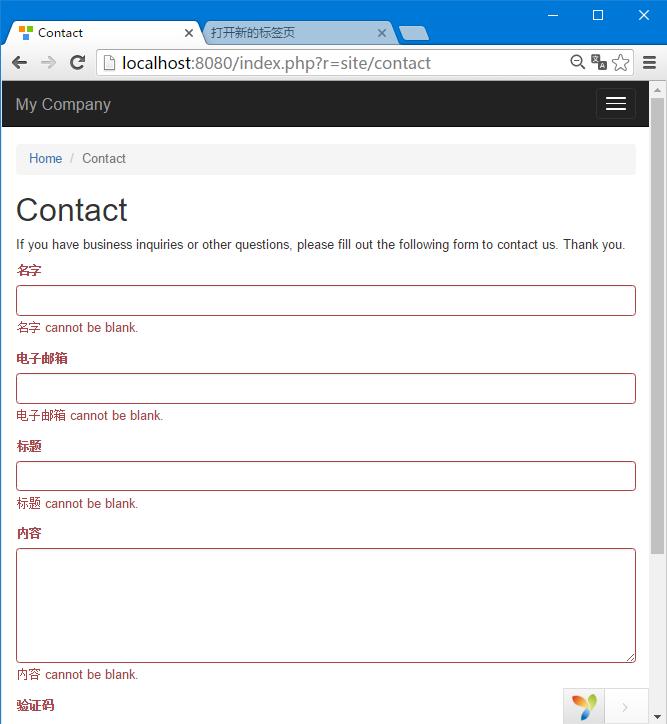
$model->scenario = ContactForm::SCENARIO_EMAIL_FROM_USER;
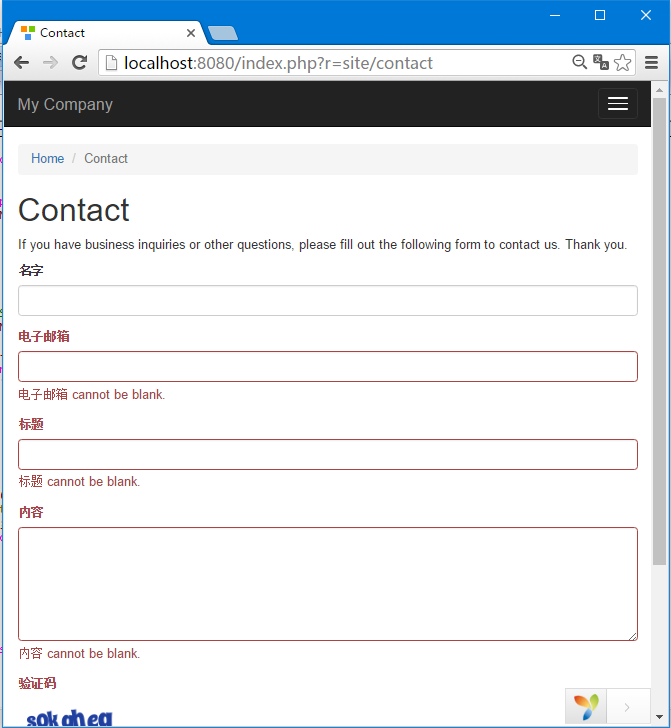
大量的分配
$mContactForm = new \app\models\ContactForm;
$mContactForm->attributes = \Yii::$app->request->post('ContactForm');
$mContactForm = new \app\models\ContactForm;
$postData = \Yii::$app->request->post('ContactForm', []);
$mContactForm->name = isset($postData['name']) ? $postData['name'] : null;
$mContactForm->email = isset($postData['email']) ? $postData['email'] : null;
$mContactForm->subject = isset($postData['subject']) ? $postData['subject'] : null;
$mContactForm->body = isset($postData['body']) ? $postData['body'] : null;
前者干净多了。注意,大量分配仅适用于安全属性。它们只是在 scenario() 函数中列出当前场景属性。
数据导出
模型往往需要以不同的格式导出。要转模型转换为数组,则修改 SiteController 的 actionShowContactModel() 函数-
public function actionShowContactModel() {
$mContactForm = new \app\models\ContactForm();
$mContactForm->name = "用户名称";
$mContactForm->email = "user@gmail.com";
$mContactForm->subject = "标题";
$mContactForm->body = "内容";
var_dump($mContactForm->attributes);
}
public function actionShowContactModel() {
$mContactForm = new \app\models\ContactForm();
$mContactForm->name = "username";
$mContactForm->email = "user@gmail.com";
$mContactForm->subject = "subject";
$mContactForm->body = "body-content";
return \yii\helpers\Json::encode($mContactForm);
}
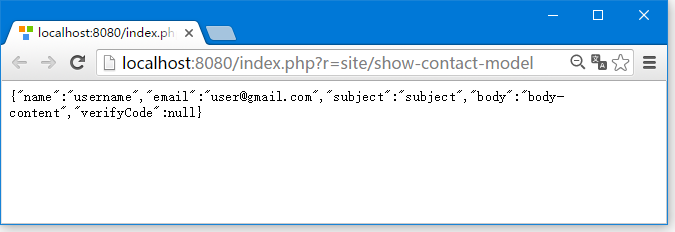
要点
- 包含业务逻辑
- 包含验证规则
- 包含属性
- 不嵌入HTML
- 不能直接访问请求
-
不要有太多的场景



